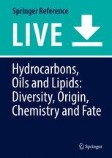Search
Search Results
-
Cuticular hydrocarbons of Gonipterus weevils: are there species differences?
Gonipterus weevils have been a taxonomic challenge for many years, with implications on our understanding of invasive species, host plant...

-
Functional Genomics of Denitrifying Bacteria Degrading Hydrocarbons
The betaproteobacterial Azoarcus/“Aromatoleum”/Thauera cluster harbors a large variety of denitrifiers capable of anaerobic degradation of aromatic...
-
Functional Genomics of Anaerobic Degradation of Hydrocarbons: An Introduction
Anaerobic biodegradation of hydrocarbons is typically studied with newly isolated microorganisms not yet accessible to genetic manipulation....
-
Hydrocarbons and Lipids: An Introduction to Structure, Physicochemical Properties, and Natural Occurrence
Hydrocarbons and lipids are among the most abundant organic compound classes in the biogeosphere. They are formed directly by living organisms as...
-
Anaerobic Utilization of Hydrocarbons, Oils, and Lipids
The book uniquely covers all aspects of anaerobic biodegradation of the environmentally important hydrocarbons. The contributions by international...
-
Anaerobic Utilization of Hydrocarbons, Oils, and Lipids
The book uniquely covers all aspects of anaerobic biodegradation of the environmentally important hydrocarbons. The contributions by international...
-
Hydrocarbons and Lipids: An Introduction to Structure, Physicochemical Properties, and Natural Occurrence
Hydrocarbons and lipids are among the most abundant organic compound classes in the biogeosphere. They are formed directly by living organisms as...
-
Assessment of the independent and combined effects of copper and polycyclic aromatic hydrocarbons on gametogenesis and sporophyte development of the kelp Lessonia spicata (Phaeophyceae, Ochrophyta)
Coastal shores near the industrial park of Quintero Bay in central Chile exhibit increasing concentrations of copper (Cu) and polycyclic aromatic...

-
Enhancing biodegradation of aged hydrocarbon-contaminated soils through toluene addition: assessing effects on solid and slurry phase treatments
The main challenge in treating aged soils highly contaminated with total petroleum hydrocarbons (TPH) is to enhance their bioavailability for...

-
Dirty workers: What do we know about the ecotoxicological studies in polychaetes?
We identified publication trends and methodological changes in polychaete ecotoxicological studies since the review carried out by Reish and...

-
Catabolic Pathways Involved in the Anaerobic Degradation of Saturated Hydrocarbons
Structurally diverse saturated hydrocarbons (n-alkanes, branched alkanes, cycloalkanes) occur frequently and abundantly in microbial habitats. A...
-
Cuticular hydrocarbon profiles of Aedes aegypti reproductive stages - a potential tool for identifying high epidemiological risk populations
The objective of this work was to determine the cuticular hydrocarbon variation in female and male Aedes aegypti at each of their reproductive...
-
Cuticular Hydrocarbon Profiles of Himalayan Bumble Bees (Hymenoptera: Bombus Latreille) are Species-Specific and Show Elevational Variation
Bumble bees are important pollinators in natural environments and agricultural farmlands, and they are in particular adapted to harsh environments...

-
Hydrocarbon-Oxidizing Bacteria of the Bottom Ecotopes of the Barents and Pechora Seas
Abstract —Microorganisms capable of degrading hydrocarbons are regular components of natural microbial communities and play an important role in...

-
Biodegradation of n-Alkanes in Oil-Contaminated Bottom Sediments under Bioelectrochemical Stimulation
AbstractDegradation of oil hydrocarbons artificially introduced into bottom sediments in a bioelectrochemical system of a membrane-free (silt) type...

-
Hydrocarbons, Oils and Lipids: Diversity, Origin, Chemistry and Fate
This book describes the structural features and properties of important types of hydrocarbons and lipids and gives an overview of their analytical...
-
Polycyclic Aromatic Hydrocarbons: Toxic Effects and Their Bioremediation Strategies
Polycyclic aromatic hydrocarbons (PAHs) are the ubiquitous recalcitrant organic compounds containing two or more fused benzene rings in their...
-
Consequences of Microbial Interactions with Hydrocarbons, Oils, and Lipids: Biodegradation and Bioremediation
In this book international experts discuss the state-of-the-art in the biological degradation of hydrocarbons to meet remedial or disposal goals....
-
The Importance of Methyl-Branched Cuticular Hydrocarbons for Successful Host Recognition by the Larval Ectoparasitoid Holepyris sylvanidis
Cuticular hydrocarbons (CHCs) of host insects are used by many parasitic wasps as contact kairomones for host location and recognition. As the...

-
Anaerobic Degradation of Hydrocarbons: Mechanisms of Hydrocarbon Activation in the Absence of Oxygen
Hydrocarbons are highly abundant in nature and are formed either via geochemical or biological processes. Their high C–H bond dissociation energies...
